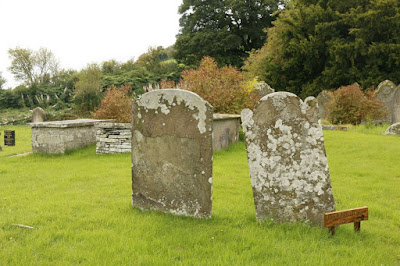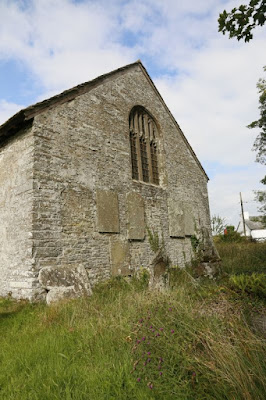Often referred to as Llanbedr Painscastle the church sits in a large churchyard and dates back to medieval times, the nave is thought to be 14th century but only a couple of things survive that date from the middle ages. In 1818 the church was described as having a tower with three bells but in 1872 Kilvert described it as being a ruin. It was restored in 1879 by J. Evins of Hereford, at the expense of Captain Mynors and the people of the parish. I came across the sign for the church when on a visit to Paincastle so took the oppertunity to visit after going to St Tielo's
The low wall and gate leading to the churchyard. The church seems a long way from the gate
Getting near to the church you find a lot of the more recent burials in the churchyard
further up you glimpse the South side and porch
the East end has a memorial on the wall and a small lancet window up high
Going round the North side shows the Chancel and nave
and walking further up to the West you see the two remaining bells
The South side is the more picturesque with the porch and churchayrd
The porch has a gate which is most likely there to keep out animals like sheep that you see grazing in the odd churchyard.
Inside we see a light and airy nave leading to a small chancel arch
Nearby is the 14th century font
Near the front of the nave is a table with the parish roll on it showing the births & deaths, might add one is quit eold
The wooden pulpit which has steps leading to it
Here we look along the nave from the pulpit
Inside the chancel looking at the Altar which also has a Barrel roof like St Teilo's
Looking back through the nave from the chancel arch
The altar with paneled back
Looking round the chancel there are quite a few memorials on the wall
Most of them date to the 1800's and a few around 1700's
Most you can read quit easy

though one is quite hard to make out
I noticed the edge of this grave poking out from under the carpet and when I lifted it found this wonderful old tomb slab
The choir stalls are quite simple and unadorned with elaborate carvings
and either side of the altar rails are these beautiful kneelers depicting wildlife you can see.
This wonderful old organ is hidden under a cover opposite the newer electric one I did not bother with
One of the windows casting light on the altar


Go outside again and you can see this wonderful lantern
On the South side wall are a couple of old memorials now unreadable
Nearby are a few small chest tombs
Looking towards the west you can see many old heastones
Over in the corner is a yew
The chest tomes vary in how they are made, being block, stone or slabs
Looking east another yew can be seen
Coffin shaped tomb slabs can be seen by this memorial
Another view of the yew at the West end
Near the porch you can see these two headstones with a sign pointing to a grave
This one which stands out
To Rev John Price MA. I'll leave you to read the story below the next photo
The wording on the gravestone plaque does not hint at the life commemorated here. It just states some basic facts that do nothing to reflect the reality of this man's devotion to his calling.
John Price was not an English gentleman, as were the vast majority of his peers in the Church of England in his lifetime, but was of farming stock from rural upland Carmarthenshire. He was an extremely bright youngster and graduated in Classics (Latin, Ancient Greek and philosophy I believe) from Queens College, Cambridge. He was ordained and placed in Lancashire by the Church until coming to a vacant living here in 1859.
His coming here was to lead to him gradually becoming known as 'the Solitary of Llanbedr Painscastle'. The church building was in a partly ruined state and without a congregation. Price's role was to develop one. However, maybe like many highly intelligent individuals he was possibly not best equipped to achieve this. Most of the upland farmers, farm laborers and their families were nominally at least Non-conformist or Dissenters or staunch Methodists, Baptists and would have been very reluctant to attend church, preferring chapel preaching, practices and religious opinions.
So Price could only afford to take the most basic accommodation for himself, despite some private income, and fell to resorting to paying his 'congregation' firstly sixpence a head to attend his services and later twopence. The result was that a large number of 'gentlemen of the road' would attend his church, along with a few n'er-do-wells, scoffers and drunks. Price even offered to marry pairs of vagrants who were 'attached' or 'living in sin' on the road as couples, paying them five shillings as an incentive. With poor eyesight and a failing grip on reality apparently he married several couples a few times each. He even provided oil-fired heaters in the colder winter months in the church and permitted tramps and hobo's to cook their dinners during his services.
Over the thirty years of his ministry here John Price sunk into an isolated, neglected state and his physical health suffered too. His generous, caring and unworldly outlook led to his being taken advantage of by travelers and the Church.
He was forced to resort to living in three bathing huts obtained from Aberystwyth, which were subsequently burgled by a vagrant and the huts were shortly afterwards burned, forcing Price to live in an upland hut little more than a chicken shed.
As an aging man he fell into his fire when asleep and was badly burned and by the time he reached his eighties had to be taken to Talgarth hospital where his clothes had to be scissored off his body and he was bathed, which resulted in his death, such was the trauma.
Eccentric he almost certainly was, but he never complained and served his ministry with devotion, comforting dying parishioners and performing his duties as best he could, despite being placed in quite the wrong locality and seemingly overlooked by his Church of England seniors and peers in a way that possibly contributed to his slow downfall.
Looking round the chancel there are quite a few memorials on the wall
Most of them date to the 1800's and a few around 1700's
Most you can read quit easy

though one is quite hard to make out
I noticed the edge of this grave poking out from under the carpet and when I lifted it found this wonderful old tomb slab
The choir stalls are quite simple and unadorned with elaborate carvings
and either side of the altar rails are these beautiful kneelers depicting wildlife you can see.
This wonderful old organ is hidden under a cover opposite the newer electric one I did not bother with
One of the windows casting light on the altar


Go outside again and you can see this wonderful lantern
On the South side wall are a couple of old memorials now unreadable
Nearby are a few small chest tombs
Looking towards the west you can see many old heastones
Over in the corner is a yew
The chest tomes vary in how they are made, being block, stone or slabs
Looking east another yew can be seen
Coffin shaped tomb slabs can be seen by this memorial
Another view of the yew at the West end
Near the porch you can see these two headstones with a sign pointing to a grave
This one which stands out
To Rev John Price MA. I'll leave you to read the story below the next photo
The wording on the gravestone plaque does not hint at the life commemorated here. It just states some basic facts that do nothing to reflect the reality of this man's devotion to his calling.
John Price was not an English gentleman, as were the vast majority of his peers in the Church of England in his lifetime, but was of farming stock from rural upland Carmarthenshire. He was an extremely bright youngster and graduated in Classics (Latin, Ancient Greek and philosophy I believe) from Queens College, Cambridge. He was ordained and placed in Lancashire by the Church until coming to a vacant living here in 1859.
His coming here was to lead to him gradually becoming known as 'the Solitary of Llanbedr Painscastle'. The church building was in a partly ruined state and without a congregation. Price's role was to develop one. However, maybe like many highly intelligent individuals he was possibly not best equipped to achieve this. Most of the upland farmers, farm laborers and their families were nominally at least Non-conformist or Dissenters or staunch Methodists, Baptists and would have been very reluctant to attend church, preferring chapel preaching, practices and religious opinions.
So Price could only afford to take the most basic accommodation for himself, despite some private income, and fell to resorting to paying his 'congregation' firstly sixpence a head to attend his services and later twopence. The result was that a large number of 'gentlemen of the road' would attend his church, along with a few n'er-do-wells, scoffers and drunks. Price even offered to marry pairs of vagrants who were 'attached' or 'living in sin' on the road as couples, paying them five shillings as an incentive. With poor eyesight and a failing grip on reality apparently he married several couples a few times each. He even provided oil-fired heaters in the colder winter months in the church and permitted tramps and hobo's to cook their dinners during his services.
Over the thirty years of his ministry here John Price sunk into an isolated, neglected state and his physical health suffered too. His generous, caring and unworldly outlook led to his being taken advantage of by travelers and the Church.
He was forced to resort to living in three bathing huts obtained from Aberystwyth, which were subsequently burgled by a vagrant and the huts were shortly afterwards burned, forcing Price to live in an upland hut little more than a chicken shed.
As an aging man he fell into his fire when asleep and was badly burned and by the time he reached his eighties had to be taken to Talgarth hospital where his clothes had to be scissored off his body and he was bathed, which resulted in his death, such was the trauma.
Eccentric he almost certainly was, but he never complained and served his ministry with devotion, comforting dying parishioners and performing his duties as best he could, despite being placed in quite the wrong locality and seemingly overlooked by his Church of England seniors and peers in a way that possibly contributed to his slow downfall.
















































































